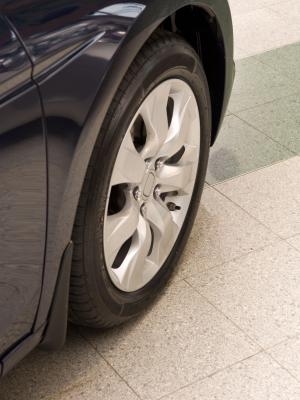
When automobile wheels are aligned correctly the tires last longer, wear evenly and the gas mileage of your vehicle improves. A necessary tool for wheel alignment, alignment turn plates measure the caster angle -- or steering pivot angle -- of vehicle wheels from the side. Manufactured alignment plates are expensive but there is an alternative for thrifty do-it-yourself enthusiasts -- make your own turn plates. Follow these instructions to create alignment plates that allow for live caster adjustments during alignment.
Determine the center of 2 of the Plexiglas squares. Draw a line between the opposite corners of one square with the ruler and marker to create an "X." The center of the "X" is the center of the square. Repeat with the second square. These are the bottom turn plates.
Place the scrap board on top of a work table close to the edge.
Create the center registration holes. Place one bottom plate on top of the board near the edge of the table. Put a top plate over the marked one and align the sides. Secure in place with 2 clamps placed near the corners of the squares. Drill through the stack at the center of the "X." Repeat with the other squares. Remove the clamps and move the pairs to the side for later.
Make a degree wheel. Place both protractors on the scanner bed with the centers lined up and the numbers mirrored. One protractor edge will overlap the other. Level the upper protractor with sheets of stacked printer paper. Scan the protractors then print the scanned image.
Lay the printed degree wheel on the scrap wood. Nail it in place through the center mark on the wheel.
Mark the degrees on bottom turn plates. Slip one of the bottom plates onto the nail over the degree wheel. Turn the plate until the 45-degree marks align with the lines drawn on the square. Tape in place then tie the string to the nail. Pull the string straight to the edge of the plate and align it with the "0"on the degree wheel. Mark the edge of the square with a vertical dash and a "0." Use the string to mark the degrees up to 35 on both sides including the unmarked lines between the numbers and label in increments of 5. Repeat on second bottom plate.
Create the corner registration hole. Slip the matching top plate onto the nail over the bottom plate and line up the edges of the squares. Drill at one corner through both squares and hammer a nail through the hole.
Draw a line on the top square from the center to the "0" at the edge using the ruler and Sharpie.
Repeat Steps 7 and 8 with the second pair of plates.
Create 4 registration pins. Snip the points off 4 nails. Measure 3/4-inch from the cut end of each nail and mark. Snip at the marks. Use these pins in the registration holes to align the plates.
Lubricate the turn plates for alignment by spreading Vaseline between each pair.